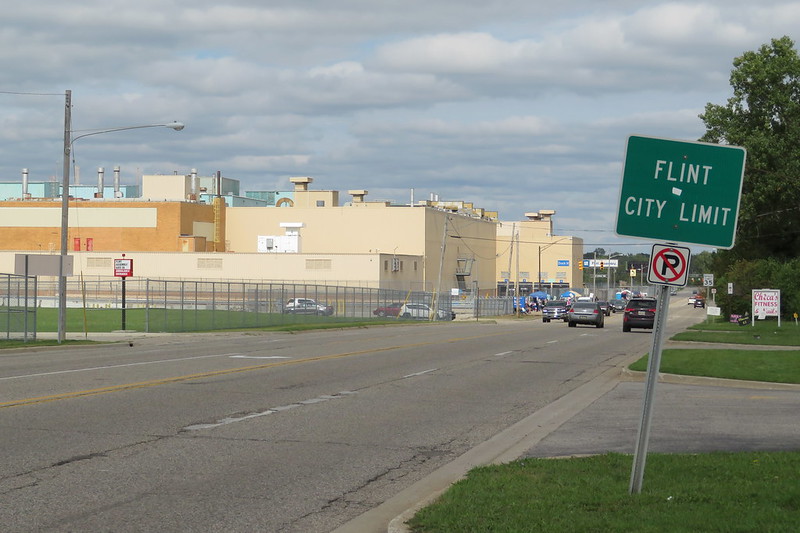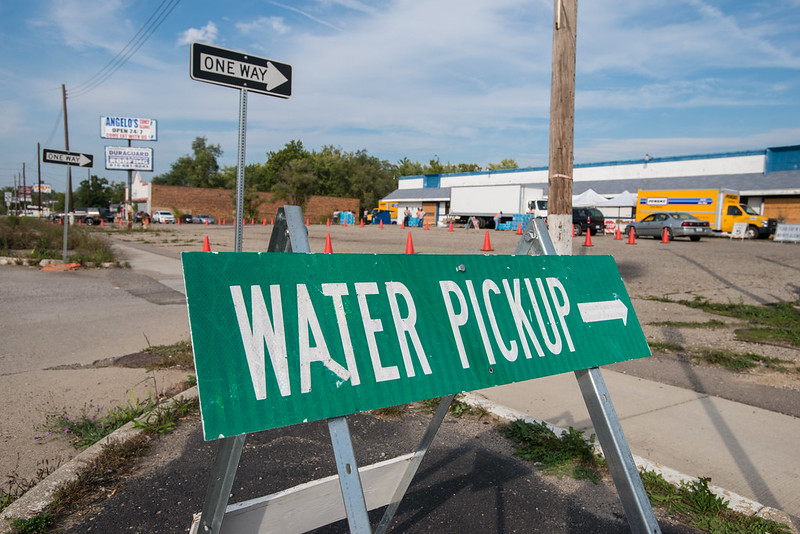On April 25, 2014, the city of Flint, Michigan, changed its municipal water supply source from the Detroit-supplied water coming from Lake Huron to the Flint River as a cost-saving measure. The new water source, however, was not treated and tested adequately, so it corroded the old water pipes, resulting in lead and other contaminants to enter drinking water.
By September 2015, a Virginia Tech research team found “serious levels of lead in the city water.” On Oct. 16, 2015, the city switched back to the Detroit water supply.
But the crisis didn’t end there.
By 2020, the rates of mental health disorders such as depression and post-traumatic stress disorder remained higher than average, according to a recent study in JAMA Network Open.
One in 5 Flint residents met the criteria for depression, 1 in 4 for PTSD and 1 in 10 for both depression and PTSD, estimates that exceed regional, national and global averages, according to “Prevalence of Depression and Posttraumatic Stress Disorder in Flint, Michigan, 5 Years After the Onset of the Water Crisis.” The study is based on in-depth online and mail surveys of 1,970 adult Flint residents between 2019 and 2020.
“We can’t know what percent is directly attributable to the crisis versus preexisting issues that have been around in Flint for a number of years, including disinvestment and concentration of poverty, which can influence mental health problems,” says Aaron Reuben, the study’s lead author and a postdoctoral scholar at Duke University and the Medical University of South Carolina. “But we find that when you compare Flint to the wider country or to Michigan, depression and PTSD are significantly elevated and we were able to connect this elevation to experiences people had during the crisis.”
Although the statistical findings of the study may not be generalizable to other regions, they add to the existing body of literature documenting the mental health effects of human-caused disasters on communities.
“Environmental disasters have significant mental health consequences, particularly when they involve toxic chemicals, misinformation being distributed, possibly criminal negligence by public officials, and they last a long time,” Reuben says.
For public official and decision makers, the message is to make mental health response part of the crisis response, Reuben says. “And it should start at day one with the assessment of need.”
The study finds several factors associated with persistent mental health conditions following the Flint water crisis, including being female, an annual income below $25,000 and previous traumatic experiences. Those who felt the water crisis had affected their health or their family’s health were also significantly more likely to meet the criteria for depression or PTSD.
Low confidence in public officials and lack of trust in the accuracy of information given by them was also linked to whether people had mental health problems later, as they continued to worry about potential health complications from exposure to contaminated water or didn’t understand what they’ve been exposed to.
“Those things are psychologically stressful and can be limited by good communication campaigns” by public officials, Reuben says.
Also significant among the findings is access and use of mental health services.
Among the respondents, 34.8% said they were offered mental health services. Among those who were offered the service, 79.3% accepted it.
“We found that when you offer services, people do want them,” Reuben says.
Despite the study’s findings, Reuben emphasized that the Flint community is remarkably resilient.
“When you look at all of the crises, the stressors, the disinvestment that the community has gone through over not just the last few years, but decades, in a way, they’re doing remarkably well,” he says. “What we want to do is just highlight that there are a number of folks who are not doing as well as they could and that we want this to be bringing attention to the lingering needs in the community.”

More on the study and its findings
The survey was conducted between Aug. 13, 2019 and April 10, 2020. Most of the data were collected before COVID-19 was declared a pandemic in March 2020, the authors write. Respondents were compensated with $35.
Slightly more than half of respondents were women. In total, 53.5% were Black, 42.5% white, 0.1% Asian, 0.3% Native American and 1.6% checked “other.” About 2% said they were more than one race.
Of the responding households, 56.8% had an annual income below $25,000 and 6.3% had an income above $75,000.
The authors say the final sample was demographically representative of Flint’s adult population. The city’s population was 80,628 in July 2021, according to the U.S. Census Bureau.
Most of the respondents — 86.8% — lived in homes directly affected by the water crisis.
In total, 97.7% said they changed their behavior to avoid or reduce exposure to contaminated water by avoiding drinking, cooking or cleaning with it. Of the respondents, 76.9% reported spending money to lower their risk by taking measures such as buying bottled water for cooking and cleaning or replacing all pipes and fixtures in their homes.
At the time of survey, 80.1% said they were concerned that exposure to the contaminated water would have long-term effects on their health.
Based on survey results, the study estimates prevalence of depression in the city was 22.1% during 2019-2020, more than double that in Michigan (9.4%), the U.S. (7.8%) and globally (7.2%), according to the study.
Prevalence of PTSD was two-to-five times greater than rates among U.S. veterans after deployment (12.1%), the general U.S. population (4.7%) and estimated global averages (2.8%), the study estimates.
Aside from factors such as gender, income and lack of trust in public officials, previous traumatic experiences were also associated with higher risk of depression and PTSD after the water crisis.
Respondents who had past exposure to any potentially traumatic events were twice as likely to experience depression, 4.5 times as likely to meet the criteria for PTSD and 5 times as likely to report both depression and PTSD compared with the general populations.
Rates were even higher for individuals who reported past physical or sexual trauma. They were 3 times as likely to report depression, 6 times as likely to have PTSD and 7 times as likely to report both compared with the general populations.
“There’s plenty of reasons the mental health problems we’re seeing today will continue unless additional services [are provided in Flint],” says Reuben. “The crisis isn’t done necessarily.”
The study has several limitations. Researchers’ estimates of depression and PTSD are presumptive because the conditions were not diagnosed by a clinician. Also, the estimates could be low if those who responded to the survey were less impaired than those who did not participate, or, high if those with unmet mental health needs were more motivated to participate.
In addition, the study doesn’t establish causal relationships between the water crisis and mental health condition, the authors note. The study also didn’t measure actual lead exposure, but the perception of it.

More research on the mental health effects of environmental disasters
Researchers have long known that natural and human-caused disasters are stressful events, and that a certain portion of the affected population will develop mental health conditions. Most studies recommend including mental health outreach early in the crisis response.
Here are a few studies on the mental health effects of environmental disasters in the U.S.:
Jackson County, Mississippi: In November 1996, one of the largest human-caused disasters in U.S. history at the time was confirmed by officials in Jackson County, Mississippi: 1,800 homes and businesses had been contaminated with the pesticide methyl parathion during a 10-year period.
The chemical, approved by the Environmental Protection Agency for spraying over fields to control insects, was being used indoors, mainly by exterminators, to kill insects, especially cockroaches. The chemical affects the nervous system and high doses can cause death. By 1997, the EPA had spent $69 million to decontaminate homes and businesses. No deaths or serious injuries were linked to the pesticide, according to Stephen Braun’s 1997 narrative piece in the Los Angeles Times.
A 2000 study, published in the journal Health & Social Work, finds 55% of those affected by the contamination, regardless of contamination levels, had symptoms of depression. The study was based on phone or in-person surveys of 115 households, between October and December 1997.
“Mental health services and support groups should be made available immediately after the disaster and remain accessible for a couple of years after the cleanup begins,” the authors write. “Because victims are unlikely to actively pursue formal providers, public awareness campaigns should begin soon after the disaster and attempt to legitimize formal mental health services and make them more readily available and accessible for low-income people.”
Graniteville, South Carolina: In January 2005, a large chlorine spill in Graniteville, South Carolina, led to death of nine people and hospitalization of 72. At least 840 people received medical treatment at area hospitals and doctors’ offices.
A survey of 225 survivors about 10 months after the spill showed that 36.9% had symptoms of post-traumatic stress, according to a study published in Social Psychiatry and Psychiatric Epidemiology in November 2011. Also, 27% of respondents reported panic attacks.
“Our findings suggest that personnel providing mental health services should be especially considerate of those with serious physical injuries,” the authors write. “Perhaps even more important than exposure, the physical morbidity resulting from a disaster is a strong risk factor for psychological distress.”
Flint, Michigan: Researchers have also studied mental health outcomes of the Flint water crisis shortly after it happened.
A 2017 study, published in the Journal of Community Psychology, used online and mail surveys of 786 Flint residents, conducted between September 2015 and September 2016, to examine the relationship between perceptions of household tap water quality and post-traumatic stress disorder symptoms.
Researchers find those who experienced poorer tap water quality during the water crisis experienced greater PTSD symptoms.
“The findings of our study underscore the negative effects of the Flint water crisis on adults and demonstrate the need for psychological interventions addressing the psychosocial effects of the crisis,” the authors write.
Jackson, Mississippi: The water crisis in Jackson, Mississippi, resulting from the failure of the city’s water treatment plants in August 2022, is a more recent example of a water disaster.
A December 2022 study, published in the journal Sustainability, uses health data from the Centers for Disease Control and Prevention to statistically compare the city of Jackson with eight nearby cities. It finds worse health status and health outcomes in Jackson compared with nearby cities, pointing to issues with the city’s hygiene and environmental health system.
“The urban water crisis in Jackson may already result in immense public health inequities, and the black communities experience significantly higher public health diseases than the majority-white cities,” writes the study’s author, Qingmin Meng. “The significantly worse mental and physical health status and the nine types of health outcomes in Jackson and Canton, which are majority-black cities in the Jackson region, than other seven non-majority black cities have showed Jackson may have started a critical degradation in public health that is still significantly threatening the black communities in Jackson, and likewise, the city of Canton.”
Meng compares the Jackson water crisis to Flint’s.
“Currently, the Jackson water crisis is significant yet overlooked for many years that may end up causing public health consequences even worse than Flint,” he writes.

Take-home message
Reuben says just providing more mental health services isn’t enough. Rather, there needs to be a holistic look at factors driving depression and PTSD in the community beyond a water crisis.
“We can’t go back and undo the crisis, but we can create a situation in which people feel that their needs are being looked after, that the information being provided by public officials are accurate,” he says.
He encouraged journalists to hold officials accountable, especially after published research points out the existing problems.
“We’ve got this study. Now what? Who’s going to do something with it?” he asks. “Get the response of folks in positions to make those decisions. What do they think of these findings? Go into the community and find people willing to be the representative, the voice and face of some of these problems.”
Additional reading
- “Experiences of the Flint Water Crisis Among Reproductive-Age Michigan Women in Communities Outside of Flint: Differences by Race and Ethnicity,” Sidonie K. Kilpatrick, et al. Journal of Racial and Ethnic Health Disparities, March 2022.
- “Lead-Laced Water In Flint: A Step-By-Step Look At The Makings Of A Crisis,” Merrit Kennedy, published on NPR in April 2016, details the timeline of the Flint water crisis.
- “‘Roach Men’ Left Toxic Trail,” Stephen Braun, published in October 1997 in the Los Angeles Times, explains the methyl parathion crisis in Jackson County, Mississippi.
- “Water, but not everywhere: Research sheds light on race and water access in metro areas,” Clark Merrefield of The Journalist’s Resource, published in November 2020, details a study that finds householders of color in the 50 largest metropolitan areas were 34% more likely to lack what the U.S. Census Bureau calls “complete plumbing” compared with white, non-Hispanic householders.
- “Racial disparities in access to running water: 5 studies to know,” Clark Merrefield of The Journalist’s Resource, published in November 2020, highlights five academic on the link between race and access to indoor running water.
- “Investigating stories on water access, affordability and safety: 5 tips to get started,” Clark Merrefield of The Journalist’s Resource, published in December 2020, lists five reporting tips for journalists.


Expert Commentary